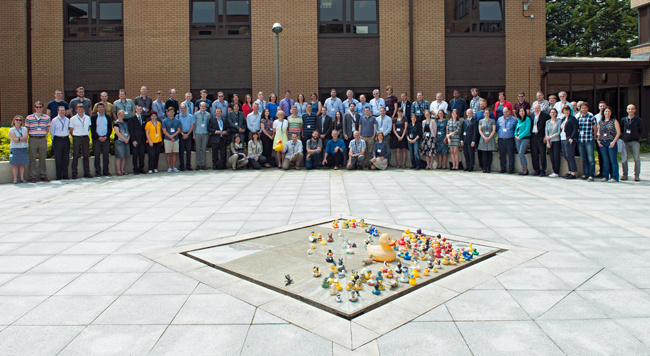ECMWF | Reading | 6-9 June 2016

High-impact weather is of particular interest to forecast users, and its prediction with a seamless ensemble analysis/forecast system is at the heart of ECMWF’s proposed new strategy. Weather can have high-impact by virtue of its extreme amplitude (e.g. tropical cyclones) or its longevity (e.g. heat-waves) and also because of its societal impacts to specific user communities. All these aspects present a particular challenge for forecasting systems, and demand considerable development of diagnostic and verification capabilities. UEF2016 focussed on the verification aspects with some emphasis on measuring quality of the forecast in a manner that is relevant to users. This year's title was:
“Shaping future approaches to evaluating high impact weather forecasts”
Brief outline
The programme contained informative talks by ECMWF staff on the latest developments of the forecasting systems and by participants, keynote addresses on specific topics to stimulate discussion and sessions where networking was encouraged. There was also be a display area for visual demonstrations and posters. The meeting covered the following thematic areas:
- High impact weather forecasts: measuring long term improvement - Forecasting of high impact weather events has become a central part of the work in NMSs, and an important aspect of the activities of commercial enterprises. The knowledge of the quality of model data and relevant ensemble-based products is essential to deliver value. The purpose of this session is to explore the use of verification scores that highlight long-term improvement of forecasts for high impact weather events.
- User-oriented verification - Measures of a model performance are an important element in building users’ confidence in the forecast. In order to achieve this, such measures need to be relevant for user communities in order to allow them to identify weather situations in which the forecast is more or less reliable, and by identifying the extent to which the forecast is useful as a basis for decision-making in weather-sensitive activities. This section will explore the progress in user-oriented verification and their added values to the user communities, with a focus on ensemble-based forecasts.
- Seamless verification across different time scales - NWP models provide forecasts for various time scales. From the verification viewpoint, this poses a challenge as the skill at different time scales will need to be compared even though verification questions may be different. This section will explore ideas for verification across time scales in an effort to provide forecast users with a seamless assessment of model skill.
Presentations
| Shaping future approaches to evaluating high impact weather forecasts David Richardson (ECMWF) |
|
| Future Earth System model and assimilation developments Erland Källén (ECMWF) |
|
| Recent progress in forecast system development Erik Andersson (ECMWF) |
|
| Keynote: Prediction and verification of extremes Petra Friederichs (University of Bonn) |
|
| The experience of Met Eireann (The Irish Meteorological Service) with a new storm naming system for Winter 2015 – 2016 Gerry Murphy (Met Eireann) |
|
| Going After High-Impact Compound Events: The Coastal-Alert-Risk (CoastAlRisk) Project of Joint Research Center Thomas Petroliagis (Joint Research Center of European Commission) |
|
| Verification of Relative-Extreme Events Michael Sharpe (Met Office) |
|
| Global Hazard Map evaluation: comparing forecast high-impact weather events against records of socio-economic impacts Joanne Robbins (Met Office) |
|
| Update on ECMWF forecast performance Thomas Haiden (ECMWF) |
|
| Diagnostics of Numerical Weather Prediction, with particular focus on Ensemble Reliability Mark Rodwell (ECMWF) |
|
| Invited speaker: Enhanced predictability during extreme winter flow patterns Ryan Maue (WeatherBELL Analytics) |
|
| Keynote: An Introduction to Seamless Verification Tressa Fowler (NCAR) |
|
|
Invited speaker: A simple method for seamless verification applied to precipitation hindcasts from two global models |
|
| Evaluation of Ensemble Streamflow Prediction Skill for the UK Shaun Harrigan (Centre for Ecology & Hydrology - CEH) |
|
| Sub-seasonal time scales: a user-oriented verification approach Laura Ferranti (ECMWF) |
|
| Verification of precipitation and drought indices forecasts at subseasonal to seasonal time scales Christoph Spirig (MeteoSwiss) |
|
| Keynote: User Oriented Verification Cristina Primo (Deutscher Wetterdienst) |
|
| Indirect verification of 100m winds through measurements of electric power in wind farms Jose-Luis Casado (AEMET) |
|
| New scoring methods for sensible weather and extreme weather Nicole Girardot (Météo-France) |
|
| Verification challenges in developing tropical cyclone response procedures based on ensemble guidance – an oil and gas industry perspective Grant Elliott (Woodside Energy Limited) |
|
| Measuring the value of ensemble forecasts to renewable energy: so much more than the ensemble mean Isla Finney (Lake Street Consulting Limited) |
|
| A Review of Weather Conditions Affecting the UK during Winter 2015/16 Dan Suri (Met Office) |
|
| Overview of three high impact synoptic events in Iceland during the winter 2015-2016 Elín Björk Jónasdóttir (Icelandic Meteorological Office) |
|
| Status, experiences and recent activities with ECMWF products at the Croatian Met. Service Lovro Kalin (Meteorological and Hydrological Service, Croatia) |
|
|
ecCharts update |
Poster presentations
| Bethany Jackson (Lake Street Consulting Ltd) | |
| Elín Björk Jónasdóttir (Icelandic Meteorological Office) | |
| Kornél Kolláth (Hungarian Meteorological Service) | |
| Ioannis Kouroutzoglou (National and Kapodistrian University of Athens) | |
| Matthias Lind (Swedish Meteorological and Hydrological Institute) | |
| Gian Paolo Minardi (ARPA Lombardia) | |
| Julia Perez (Flood Forecasting Centre) | |
| Lorenzo Ramella Pralungo (DufEnergy Trading) | |
| Thomas Schumann (Deutscher Wetterdienst) | |
| Anastasiya Stoycheva (National Institute of Meteorology and Hydrology) | |
| Thomas Vanhamel (RMI) |
